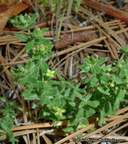Taxon Report
Galium californicum H. & A. ssp. primum Dempster & Steb.Alvin Meadow bedstraw |
 © 2013 Keir Morse |
Taxon Summary
Galium californicum ssp. primum, commonly known as Alvin Meadow bedstraw, is a perennial herb in the Rubiaceae that is found only in California. It occurs within Chaparral, and Lower montane coniferous forest, growing at elevations from 1350 to 1700 meters. Galium californicum ssp. primum is ranked 1B.2, Plants Rare, Threatened or Endangered in California and Elsewhere; Moderately threatened in California.Classification
|
Scientific Name: |
Galium californicum H. & A. ssp. primum Dempster & Steb. |
|
Common Name: |
Alvin Meadow bedstraw |
| Family: | Rubiaceae |
| Element Code: | PDRUB0N0E6 |
| USDA Plants Symbol: | GACAP |
|
Synonyms/Other Names: |
|
Ecology and Life History
| Lifeform: | perennial herb |
| Blooming Period: May-Jul | May-Jul |
| Elevation: | 1350-1700 (4430-5580) |
| General Habitats: | Chaparral, Lower montane coniferous forest |
| Microhabitat: | Granitic, Sandy |
| Microhabitat Details: |
Conservation Status
| CA Rare Plant Rank: | 1B.2 |
| Global Rank: | G5T2 |
|
State Rank: |
S2 |
| State List: | None |
| Fed List: | None |
| Other Status: | BLM_S; SB_CalBG/RSABG; USFS_S |
|
CRPR Changes: |
|
Occurrence Data from the CNDDB
| Total Occurrences: | 12 |
| Element Occurrence Ranks: | |
| Excellent (A) | 0 |
| Good (B) | 1 |
| Fair (C) | 1 |
| Poor (D) | 0 |
| None (X) | 0 |
| Unknown (U) | 10 |
| California Endemic: True | |
| California Counties and Islands: Name (Code) | |
| Riverside (RIV), San Bernardino (SBD) | |
| Quads: Name (Quad Code) | |
| Blackburn Canyon (3311667), Cahuilla Mtn. (3311657), Idyllwild (3311666), Lake Fulmor (3311677), San Bernardino South (3411713) | |
Threat List Data from the CNDDB
| Threat List Total: | 5 | |
| EOs with Threat Listed: | Total EOs | % of EOs |
| 3 | 25 % | |
| Hybridization | 3 | 25% |
| Logging | 1 | 8% |
| Recreational use (non-ORV) | 1 | 8% |
| Road/trail construction/maint. | 1 | 8% |
| Vandalism/dumping/litter | 1 | 8% |
Citation
California Native Plant Society, Rare Plant Program. 2025. Rare Plant Inventory (online edition, v9.5.1). Website https://www.rareplants.cnps.org [accessed 21 December 2025].